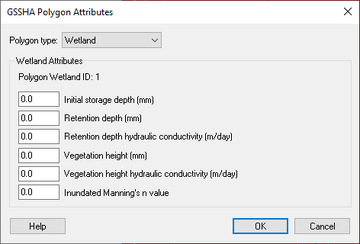WMS:GSSHA Feature Polygons
Feature polygons in GSSHA can be used to simulate lakes and wetland areas. In general, lakes and detention basins should be defined at a point by defining a detention basin hydraulic structure at a point attribute on a stream in a GSSHA coverage. Wetlands should generally be created as feature polygons in a GSSHA coverage. By attenuating and storing the incoming flow, lakes and wetlands prove to be important hydrologic features of a basin and dramatically alter the response of a watershed to a precipitation event. Both in-stream and out-of-stream lakes and wetland areas can be simulated in this way. Lake and wetland polygons are conceptually modeled in WMS in the GSSHA coverage.
Lakes and wetlands must be used in conjunction with a rating curve (or other curve or hydraulic structure, if applicable) at the outlet to describe how they release the stored water. The rating curve is set up as a hydraulic structure at the outlet node of the lake or wetland.
The wetland areas are treated as simple flow storage areas with special sediment conditions. The wetland sediments are treated as a lens that must be saturated before it will release water into the groundwater domain. Thus, five parameters must be specified for the wetlands area. These are the maximum storage depth, the retention depth (sediment lens thickness), the base elevation, the hydraulic conductivity of the sediment lens, and the hydraulic conductivity of the soil just below the sediment lens (retention depth).
Lake polygons are used to define cells within a grid used to simulate lakes during a GSSHA simulation. Initial leakage discharge, spillway crest width, discharge coefficient, initial water elevation and crest elevation must be defined for each lake.
Wetlands can be created as feature polygons in a GSSHA coverage and define the cells that form part of a wetland. Five parameters must be specified for each wetlands area. Wetland areas store small amounts of water and act as important aquifer recharge areas. The areal parameters are assumed to be homogeneous over the polygon. The wetlands areas will act as small lakes with slightly different infiltration parameters. A different hydraulic conductivity value can be specified for the sediments responsible for the wetland condition if a high water table is not the principle cause of the wetlands. The wetlands and lakes do not have any special sediment trapping or contaminant removal parameters. They are simple treated as modifying the stream and overland flow processes. Lakes and wetlands may be in-stream or out-of-stream features.
For information on modeling lakes as hydraulic structures instead of polygons, please see the WMS:GSSHA Hydraulic Structures article.
GSSHA Polygon Attributes Dialog
The GSSHA Polygon Attributes dialog has four different Polygon type options that can be selected from the drop-down menu. Only the "Wetland" option has user-changeable attributes.
- "Generic" – No additional attributes.
- "Boundary" – No additional attributes. Boundary polygons are used to define the perimeter of the watershed and are used for creating grids from an already known watershed boundary.
- "Wetland" – The following options are available in the Wetland Attributes section:
- Initial storage depth – A decimal value in millimeters.
- Retention depth – A decimal value in millimeters.
- Retention depth hydraulic conductivity – A decimal value in meters per day.
- Vegetation height – A decimal value in millimeters.
- Vegetation height hydraulic conductivity – A decimal value in meters per day.
- Inundated Manning's n value – A decimal value.
- "Depression Mask" – No additional attributes. Depression mask polygons mask cells contained within the polygon. The elevations of the cells located inside a depression mask polygon are not altered when the CleanDam program is run from WMS.
